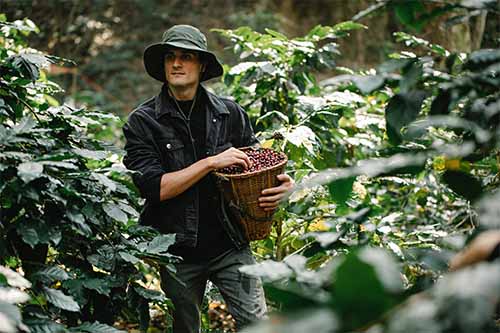
Where Are the Best Coffee Beans in New Zealand?
Nothing beats the sensation of that first sip. A new coffee flavour you’ve never tried before — and now it’s all yours. As the caramel

There are many facets to coffee flavours, from the aspects of the farm that the beans are grown in, right down to the roast profile. One aspect that influences the flavour of the coffee is the altitude that the beans are grown in.
Some parts of the world have different signature flavours that come out of them. Ethiopia’s coffee for example usually packs a real fruity flavour. One reason for this is that their farms are at a high altitude. Colombia on the other hand usually farms at a lower altitude, and it’s beans have more of a chocolate taste.
Many of the coffee beans grown at very high altitudes, ie above 1500m tend to have fruity flavours. When tasting a cup of coffee from a very high altitude in a cupping, you might find flavours like wine, berry, floral, spice or fruit. Coffee from Ethiopia tends to taste this way, grown at high altitudes, and because of it’s hot climate using a dry processing method, coffee beans out of Ethiopia tend to exhibit floral or fruity notes and are best enjoyed black.
Coffee grown at a high altitude, between approximately 1200 and 1500 meters, tend to have nutty or chocolate flavours. When tasting coffee from a high altitude, you might find notes like nut, chocolate, vanilla, or citrus. The majority of coffee we consume every day comes from this altitude. Places like Colombia are well known for coffee grown here, and because of it’s semi-dry processing method, coffee from this region tends to be sweet and chocolatey.
Medium altitude coffees tend to avoid many of the citrus or fruit notes, and just appear smooth and sweet. A lot of coffee from Brazil tends to fit into this category. Much of the coffee we drink every day fits into this altitude, ranging from 900m to 1200m, it provides a very consistent flavour profile, for a very consistent flat white.
Low altitude is where coffee growing really starts to get interesting. Coffee grown at this altitude tends to exhibit earthy, muddy, and almost vegetable type flavours. Some people really enjoy this kind of coffee, but it’s not for everyone. If it doesn’t sound appealing to you, you might want to aim for above 900m for your coffee beans. A lot of coffee from the low-lying plantations of Indonesia will exhibit these flavours.
It’s good to try all the different altitudes before you make a decision, but don’t pin everything on altitude either. There are a lot of other aspects that change coffee beans’ flavour profiles, like processing method, climate, and roast profile. If you feel like you need some help getting matched with the perfect coffee for you, our quiz will find your flavour profile, and then match you with coffee beans whose attributes suit your tastes.

Nothing beats the sensation of that first sip. A new coffee flavour you’ve never tried before — and now it’s all yours. As the caramel

Coffee – it’s more than just a morning pick-me-up; it’s a journey of discovery. For many, the quest for the perfect cup begins with the

In 2020, something huge happened. The COVID19 pandemic and ensuing lockdowns created an opportunity for people to explore making coffee at home. Coffee machine sales

Nestled on the picturesque South Island of New Zealand, Christchurch is a vibrant city that boasts a thriving coffee culture. With its array of trendy

As coffee enthusiasts, we understand the significance of that first sip in the morning or the delightful mid-afternoon pick-me-up. At Bean Merchant, we pride ourselves

It’s important to understand the advantages of making a purchase of a specialised coffee grinder. Many of you will know about the significance of freshly
Copyright ©️ 2024 Bean Merchant. All Rights Reserved.
We do not hold financial information, all secure data is encrypted via Stripe.
Try our unique coffee flavour profiling quiz to find your perfect coffee beans.
Bean Merchant is New Zealand’s most relied upon curator for home coffee delivery. Whatever coffee flavours you are after, we have the widest variety to choose from.